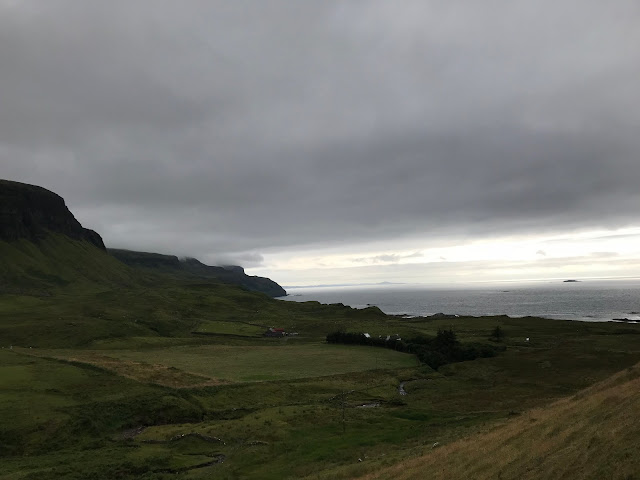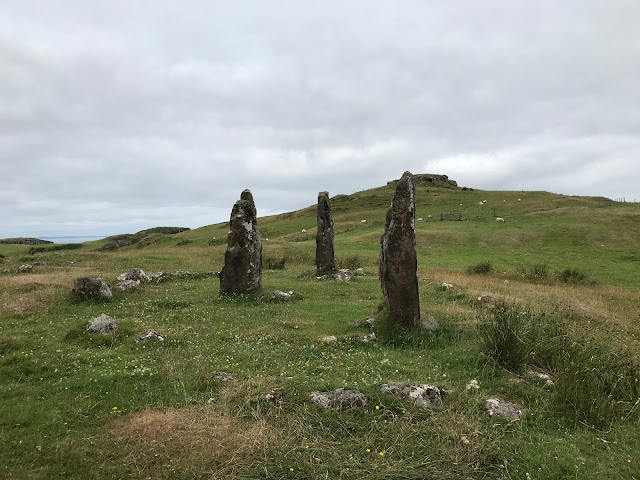One of the oldest churches in the UK is not far from where I live now. It is called St Peter's Church, Monkweathmouth. Founded as a monastery in 674-5, it became one of the most important centres for learning and religion in the early medieval period, not just in Britain, but in western Europe. The church was to be a base for the Roman Church, which was in a constant struggle with the Iona/Celtic/Irish Church, which previously held more sway in Northumbria.
In 682 the Pope issued a letter freeing the monastery of all control, meaning it answered to Rome only, rather than any Bishop or secular authority. The monastery was deemed so successful and important that another monastery was built nearby, in what is now Jarrow. It is only about 9 mines away, and the two monasteries were very close, effectively acting as one monastery on two sites, rather than two independent institutions. I haven't been to Jarrow yet, but it is on my list.
The Venerable Bede, a monk who was given to the monastery when he was less than ten, was one of the first monks to move to Jarrow. He spent most of his life between the two monasteries, where he wrote what is arguably the most important piece of Anglo Saxon history we have, The Ecclesiastical History of the English Church and People. It is the first history every written about Britain, and is still cited today. Interestingly, if you ever hear someone say that the name Easter comes from the Anglo Saxon goddess named Eostre (or some similar spelling), they are repeating Bede. Bede is the only source for this 'fact', and the name, and its variants, do not exist anywhere else. It is likely not true, but it does attempt to explain why English is the only European language that does not use a word derived from the Latin and Greek 'Pascha' for Easter.
Only the tower remains of the original Saxon church, but there is a model showing what archaeological excavations show was once on the site.
The main body of the church is connected by a walkway to the dormitory and store rooms. The addition to the east end of the building is fairly typical of Saxon churches, where additions were added on to the east end somewhat haphazardly. There is a covered walkway that surrounds the church, which is pretty unusual. It may have acted as a walkway for monks to exercise while maintaining their seclusion. This would be essentially the same as the cloister walks of later churches. The walkway is now gone, but the doorways from it into the western tower can still be seen.
 |
| The doorways that once connected the walkway to the tower. |
 |
| The interior fo the tower, with the door leading into the church. The glove slabs are either side or much later. |
There are a few other excavated items in the church that show its medieval past. Since this was a monastery it was headed by an Abbott (from the Hebrew 'abba', meaning 'father'). The Abbott had a throne, and they believe that parts of it were found. They have reconstructed what it may have liked like, based on other thrones that have been found, and they few piece they found from the site.
The image is a lion, though when you have medieval stone masons who have never actually seen a lion you get interesting interpretations. If you want a laugh, look up pictures of elephants in medieval art.
Some other pieces, mostly of funerary artefacts, are also on display in the church.
The upper grave slab is very interesting, as the inscription is on two parts. The first is well down, using correct Latin to give a generic epitaph. However, the inscription is continued with a much less experienced mason who does not know Latin very well. It is in this second half that the inscription makes personal notes about the person who was buried under the stone. It seems like that the slab was either (1) intended for someone else, but then a priest died who needed it more urgently, or (2) it was mass-produced by a travelling stone mason, ready for personal details to be filled in by someone else when it was needed. The lower image is of a monk, likely a later Abbott.
Inside the church all that remains of the Saxon building is the western wall. In classic Anglo Saxon style it is thick, with small openings. The door in the middle of the wall, off the ground, is how you access the tower, via a very precisely, and precariously placed ladder.
 |
| The original Saxon doorway into the church. Some of the most important Anglo Saxon historical figures most definitely walked through this door. |
There is a curious symbol that is not entirely understood, but seems to have been the symbol of the monastery.
 |
| A Victorian mosaic floor in the chancel, showing the symbol. |
The exterior of the building is classic medieval/Gothic revival, but the tower is what points to the building's past. It stands on a hill overlooking the mouth of the river Wear, where it gets its name: Monk (it was a monastery) Wear (the river) Mouth (on the mouth of the river): Monkwearmouth. As an interesting linguistic aside (interesting to me, at least), in the north east of England the suffix '-mouth' is pronounced as you would for the part of the face, rather than the more common 'muth' that you get in most of the rest of the UK.
A harbour and port were on the site since before the monks came, and still the area is reliant on shipping. Georgian and Victorian ships used to carry sand in their hulls as ballast on their way to port, which was unloaded once they arrived. The sand and stones were offloaded around the church, so by the end of the 19th century the church, which once sat on the top of a hill, was situated in a dip, surrounded by an artificial berm made of the offloaded ballast. Ironically, the sand was piled around the base of the tower, which ultimately preserved it was the pollution and vandals that would have chipped away at the Saxon porch.
The church from the south (where the former monastic buildings once stood), looks its best. The ugly, post-war tower blocks to the left contrast with the building.
When you see the church from the air you can see the layout of the former monastic buildings. There is a walkway connecting the long building (as long as the church).


























































